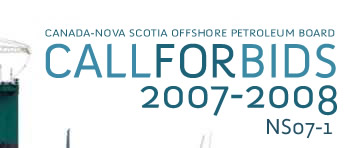
CANADA-NOVA SCOTIA OFFSHORE PETROLEUM BOARD


Geoscience Research Centre
The Board's Geoscience Research Centre (GRC) provides geological and geophysical information and services for the Nova Scotia offshore area.
In addition to staff offices, the facility consists of three working areas: a data and core storage warehouse, public viewing rooms, and a micro-paleontology laboratory. Subsurface samples from 204 offshore petroleum exploration and development wells drilled by industry in Nova Scotia offshore area are stored at the facility. The facility curates a current hard copy inventory and microfiche record of geological, well history and geophysical information. Examination space, data, and materials for study are made available to the public free of charge, with hours of operation weekdays from 8 AM to 4 PM.
| Facility Facts | |
| Wells drilled in N.S. offshore area (to December 2006) | 204 |
| Spud date of oldest well (Sable Island C-67) | June 7, 1967 |
| Drill core in storage | 4,304 boxes |
| Meters of drill core in storage | 4,286.05 m |
| Sidewall cores in storage | 14,128 vials |
| Washed cuttings in storage (approximately) | 160,594 vials |
| Unwashed cuttings in storage (approximately) | 139,746 bags |
| Geochemistry samples in storage (approximately) | 11,549 jars |
| Size of data and sample storage area | 390 m2 |
| Released geological & geophysical reports | over 365 |
The facility's 1200 m2 data and core storage warehouse archives all geological and geophysical reports, well site survey reports and several types of subsurface samples. The facility houses geological samples and prepare cores and cuttings for the extraction of microfossils and the processing of palynological residues. It also maintains a micropaleontology data bank and curate cores, cuttings, prepared residues and picked slides for examination by academic, industry and government scientists. Unwashed cutting samples are kept in plastic lined cloth bags, and geochemistry samples are stored on one litre plastic jars. Bulk unwashed cutting samples, geochemistry jars, and all drill core are stored in cardboard boxes which in turn are stored on racked pallets. Washed cutting samples are in 25 mL plastic vials arranged in trays which are stored in steel cabinets. Sidewall cores are stored in 25 mL plastic vials in steel storage cabinets, as are the collections of picked micropaleontology and palynology slides. Samples from well site seabed surveys are also curated. Fluid samples are also archived and are stored in 1 L glass jars. Recent fluid samples are stored in a flammable goods freezer.
Each well is assigned a unique file reference number (known as a D number) and all related subsurface materials are identified by means of that number.
The facility's public examination area consists of four rooms, two having layout tables for studies of cores and samples, and the other two containing desks and microfiche viewing equipment. A binocular microscope and other sample examination aids are available to users upon request. Requests to sample materials in storage must be submitted in writing with an outline of the type of study to be conducted. If permission to sample is granted, the size of sample is determined with reference to the amount remaining and also the nature of the study. The amount of sampling and the degree of duplication of studies is strictly regulated. All unused sample must be returned to the facility and one copy of the results of the study are to be forwarded to the Board's office in Dartmouth.
The facility's laboratory is able to process samples from wells for extraction of micropaleontological material. Access to the laboratory is provided for users wishing to prepare their samples taken for palynology processing, vitrinite reflectance, petrology, etc. The laboratory also contains equipment for petrological determinations, which includes a rock saw to sample cores for thin sections.
Over 350 released geological and geophysical reports covering the Nova Scotia offshore area are currently available for inspection. There are approximately 204 well history reports currently available for viewing for the Nova Scotia offshore area. The completeness and quality of reports vary depending on operator and the program vintage.
The GRC also houses the Board’s digital Data Management Centre.
For additional information, please E-mail: callforbidsgrc@cnsopb.ns.ca
return to top of page